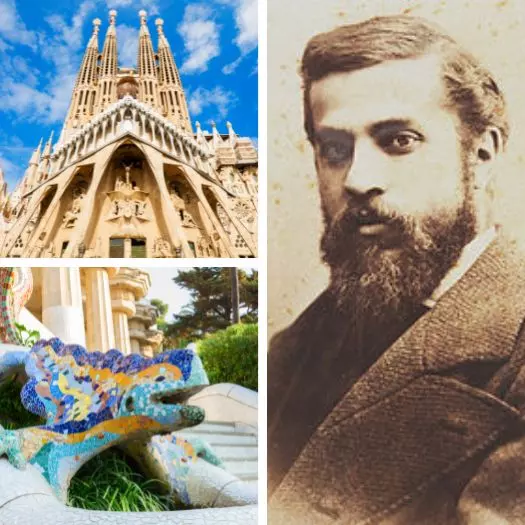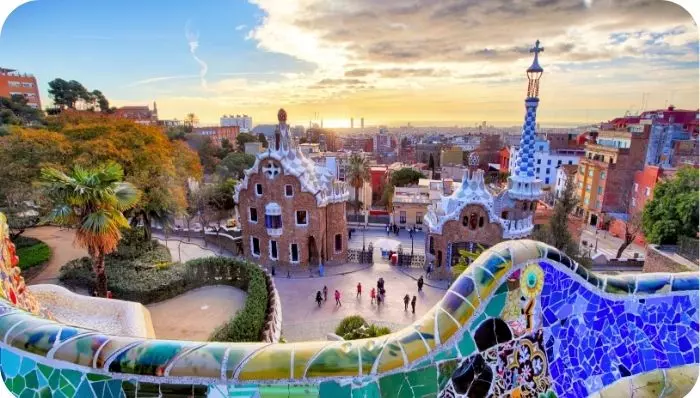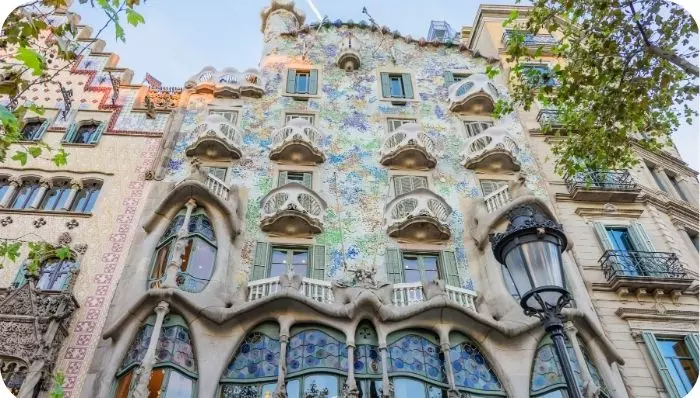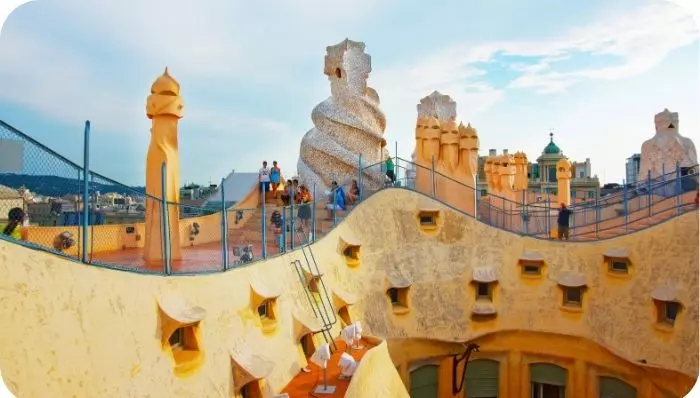Did you know that the Sagrada Familia, Park Güell, Casa Batlló, and La Pedrera, icons of Barcelona, were the work of the same artist?
Barcelona would not be what we know it today if it were not for Antoni Gaudí, the most important representative of Catalan Modernism. His unique vision, inspired by nature and organic forms, has given life to buildings that defy imagination and redefine the canons of architecture.
In this post, we invite you to explore his four most famous works through this tour of the best of Gaudí buildings in Barcelona.

Who was Gaudí?
Antoni Gaudí i Cornet (1852-1926) was a Spanish architect, the greatest exponent of Catalan Modernism and one of the most influential of the 20th century. His work, deeply rooted in nature and characterized by his unique artistic vision, has made Barcelona a world benchmark for architecture.
Gaudí’s deep religiosity marked his work in a significant way. His architecture becomes an expression of faith, in which every detail has a symbolic and religious meaning. Inspired by nature, Gaudí sought to imitate its organic forms and create buildings in harmony with the environment. To do so, he developed innovative construction techniques that allowed him to overcome the limitations of traditional architecture.
His works, declared a World Heritage Site by UNESCO, are admired by millions of people around the world. Among the most emblematic are the Sagrada Familia, Park Güell, Casa Batlló, and La Pedrera.
1. Sagrada Familia

Our journey begins at the Sagrada Familia (eng. Holy Family), Gaudí’s masterpiece and one of the most iconic buildings in Barcelona. This imposing basilica, still under construction since 1882, represents the culmination of the artist’s creative genius. It is also the second most visited monument in Spain, right after the Alhambra in Granada.
Inspired by the Holy Family, nature, and religious elements, its design is an ode to faith and beauty. The Sagrada Familia’s symbolism is deeply religious. The three facades represent the Nativity, the Passion, and the Glory, respectively. Each element of the building, from its towers to its stained glass windows, carries a profound religious meaning.
With its intricate facades, columns that resemble tree trunks, and multicolored stained glass windows, the Sagrada Familia is a work of art that will leave you breathless.
How to Get to the Sagrada Familia from Barcelona?
There are several ways to visit the basilica:
- Metro: Lines L2 and L5 have stops right at the entrance of the Sagrada Familia.
- Bus: Use bus lines 19, 33, 34, D50, H10, and B24.
- Barcelona City Tour Hop-On Hop-Off Bus: Stop 11 on the East/Green Route
If you are interested in taking a guided tour of the Sagrada Familia to learn about every detail of its construction and more about its history, here are some options:
Sagrada Familia Guided Visits
2. Park Güell

Our journey through the best of Gaudí buildings Barcelona continues as we head to Park Güell, an urban park that, originally, the artist envisioned as an ideal garden city. In this magical space, nature harmoniously blends with architecture, creating a dreamlike atmosphere that will transport you to another world.
Don’t miss capturing photos of the park’s captivating viaducts, sloping passageways, the iconic Dragon Staircase, Plaza de la Naturaleza, and the Portico de la Lavandera. From the park’s summit, you can also enjoy stunning panoramic views of Barcelona.
Did you know? The iconic dragon on the stairs, a symbol of Park Güell, wasn’t just a decorative element. It actually served a practical purpose! The dragon was part of a clever drainage system designed by Gaudí. This system collected rainwater to supply and irrigate the park, with excess water flowing out of the dragon’s mouth, creating a beautiful and functional feature.
Park Güell is brimming with such hidden secrets and details waiting to be discovered. To ensure you don’t miss anything, consider joining a guided tour with a local professional!
How to get to Park Güell from Barcelona?
To get to Park Güell easily, we recommend you to follow one of these options:
- Metro: Line 3. Get off at Lesseps station. It’s a 20-minute walk from the station to the park. The recommended entrance is via Avinguda del Santuari de Sant Josep de la Muntanya (which has escalators). Avoid entering from Vallcarca station on Line 3 as the escalators are currently out of service.
- Bus: Lines H6 or D40. Get off at the Travessera de Dalt stop. It’s a 10-minute walk from the bus stop to the park. We recommend entering via Avinguda del Santuari de Sant Josep de la Muntanya (which has escalators) or Carrer de Larrard for easy access.
- Barcelona City Tour Hop-On Hop-Off Bus: East/Green Route. Get off at stop 13. It’s a 5-8 minute walk from the bus stop to the park.
Park Güell Guided Visits
3. Casa Batlló

Our virtual tour of Gaudí’s building marvels in Barcelona takes us to the heart of Passeig de Gràcia, where a masterpiece of Catalan Modernism stands tall: Casa Batlló. This creation of Antoni Gaudí’s genius is a voyage into the realm of imagination, where nature and architecture intertwine in a symphony of colors, forms, and symbolism.
Stepping into Casa Batlló is entering a dreamlike realm where every detail comes alive. The façade, inspired by the marine world, evokes the scales of a dragon with its undulating curves and vibrant hues. The balconies, resembling carnival masks, peer down at visitors with a mischievous gaze. Inside the building, nature manifests itself in every corner: columns resembling tree trunks, stained glass windows mimicking the sky and sea, and mosaics depicting the Mediterranean flora and fauna.
Declared a UNESCO World Heritage Site in 1999, Casa Batlló will leave you awestruck. You’d be surprised to know that this magnificent building has no straight lines. Every element, from the walls to the furniture, appears to be in motion, following organic forms inspired by nature.
How to get to Casa Batlló?
If you plan to visit Casa Batlló, you can follow some of these directions:
- Metro: take metro line L2 or L4 to Passeig de Gràcia station. Once at the station, follow the signs to the “Passeig de Gràcia / Gran Via” exit. When you leave the station, you will find yourself on Passeig de Gràcia. Walk about 150 meters along Passeig de Gràcia in the direction of Diagonal street until you reach Casa Batlló.
- Bus : take the bus V15, 7, 16, 22 or 24 at any bus stop in the city. Get off at the stop “Passeig de Gràcia / Aragó”. Walk about 100 meters along Passeig de Gràcia until you reach Casa Batlló.
- On foot: if you are in the center of Barcelona, you can walk to Casa Batlló by taking Passeig de Gràcia. You will arrive in just 10-15 minutes.
- Barcelona City Tour Tourist Bus: East/Green Route, stop 16 “Casa Batlló”. You can also take the Orange Route and get off at stop 19 “Casa Batlló”.
Casa Batlló Guided Tours
4. La Pedrera
We conclude this tour of the best of Gaudí in Barcelona with La Pedrera, also known as Casa Milà. Designed and built between 1906 and 1912, La Pedrera was commissioned by entrepreneur Pere Milà as a private residence and apartment building.

One of the most outstanding features of La Pedrera is its undulating facade, which appears to flow like waves in the sea. Gaudí used local limestone to create a textured and organic surface, with wrought-iron balconies that twist and turn uniquely on each floor. Another highlight of La Pedrera that you must visit is its spectacular rooftop, which offers panoramic views of Barcelona and is adorned with surrealistic chimneys that resemble sculptures from another world.
Nowadays, La Pedrera is a museum and cultural center. However, did you know that the basements of La Pedrera served as air-raid shelters during the Spanish Civil War? And that at the beginning of its construction, it was mocked for its unusual shape? And that it also received many fines from the city council for defying what was, up to that point, the norm in architecture?
La Pedrera is located just a few meters from Casa Batlló, so you have no excuses not to discover these two attractions in one visit.
Definitely, Gaudí’s La Pedrera is a must-visit in Barcelona and deserves a thorough exploration to uncover all its secrets. Don’t miss exploring it!
Guided tours to La Pedrera
Now that you know these amazing four Gaudi buildings in Barcelona, you’re ready to plan your itinerary and set out to discover them. Whether on a guided tour or solo adventure, these architectural wonders deserve a spot on your Barcelona bucket list as they undeniably represent the essence of the city!
If you visit any of these attractions with our tours, tag us and share your experience with us on social media! 📷
Follow us for more tips and inspiration for your travels! 💖


